What Is A Flint And Steel & Ferro Rod?
There is a lot of confusion in the camping and outdoor world about what is a flint and steel, and what is a ferro rod?
A lot of people incorrectly label a ferro rod as a flint, or flint and steel.
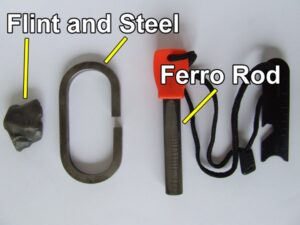
Added to the confusion is the magnesium bar fire starter, which also incorrectly gets labeled a flint.
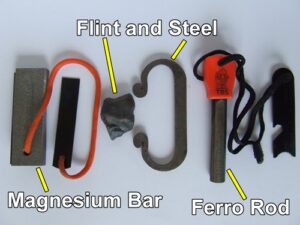
So let’s look at what is a ferro rod, and what is a flint and steel? Also the difference between a ferro rod and a magnesium bar fire starter.
The devices all work in different ways and some take more steps then other to get a camp fire going. The fire starters all have positives and negatives about them.
Here is what a flint and steel looks like compared to a ferrocerium rod and a magnesium bar fire starter.
We will cover each item and look at it more detail.
What is a ferro rod?
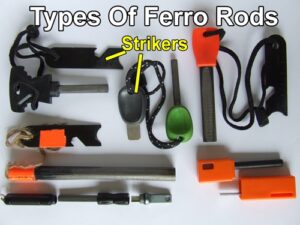
A ferro rod is short for ferrocerium rod. It is made up of a mixture of metals.
A ferro rod can also be called a fire steel, Swedish fire steel, metal match and mischmetal rod (Because of the composition of materials in it.) It sometimes is called an artificial flint. It is often incorrectly called a flint, or flint and steel.
The rod normally comes with a striker or scraper that you use to quickly scrape bits of metal off the ferro rod, creating sparks.
What tinders work with a ferro rod?
The sparks are fairly hot from a ferrocerium rod, so it can ignite a broader range of tinder’s then a flint and steel. However, the ferro rod won’t ignite all material easily. Most tinder materials have to be processed down into small fibers and be dry for it to catch on fire.
There are dozens of commercial fire starters that work well with the ferro rod. FireStrip roll, fire starter gels, tinder blocks and the ones that you put into a fireplace can work with the ferrocerium rod.
You can make your own with DIY fire starters with cotton balls coated with Vaseline on it. These burn for a while and are cheap and easy to make.
If you want to use natural plant materials, most tinder’s have to be very dry and finely processed for the sparks to ignite the tinder.
The natural materials should be shredded, rubbed, crushed and rolled very fine. Dry leaves, bark, wood scrapings/dust, feather sticks, dry grasses, plant seed heads, dried herbivore dung and tinder funguses can work with the ferro rod.
How do you use a ferro rod?
Before using a brand new ferro, the black protective coating has to be scraped away.
There are several ways to use the ferro rod to get sparks. However, the basis of these methods is the striker can be pushed along the ferrocerium rod, or pulled back on it.
One technique is to have the tinder underneath the ferro rod. The ferro rod is held stationary pointing 45 degrees down onto the tinder. The hand with the striker quickly and firmly pushes it along the rod creating sparks.
A common mistake of beginners is to pull both hands away from the sparks as they don’t rightly won’t to burn themselves. The sparks go into the air and don’t land onto the tinder bundle. Angle the rod so the sparks land into the tinder.
Another method for using the ferrocerium rod is to hold the scraper stationary and pull back on the ferro rod. The tinder is underneath and with this technique has the advantage that scraper doesn’t push the material away and scatter it. (Sometimes like the first method.)
Some other methods of striking the ferro rod a scrapping it back and forward quickly, rather than one long push.
Another way to use a ferro rod is to use the thumb on thumb method to scrape the fire steel removing a fair amount of material.
Ferro rod problems. – If you are having trouble getting a campfire going, check you are getting plenty of sparks with the ferro rod. (If not is the black protective coating removed.)
Check you are striking or scraping the ferrocerium rod firmly enough and with a quick motion. If you are only getting minimal sparks, try a scraper with a sharper angled edge.
If you are creating heaps of sparks, take notice where they are going. Are the sparks going onto the tinder, or going into the air?
If the sparks are hitting the tinder, but not catching into flame, try processing the tinder into finer pieces. If that doesn’t work, try some different materials.
Ferrocerium rod strikers (scrapers).
Generally a bigger striker / scraper is easy to use then a small one. As holding a larger one is easier and you can also use more force with it.
Ideally for the striker to work well with the ferro rod it needs to have a hard, almost sharp edge to help remove the ferrocerium material.
If you lose your striker, you can scrape the ferrocerium rod with a number of items like a piece of glass, broken bit of porcelain, spine of the knife and saw blades, to get sparks.
You can use the back of the knife (spine) to scrape sparks with a ferro rod.
The knife can be a high carbon steel or stainless or any type of steel for it to work. (The type of steel is only important for a flint and steel. As the steel striker should be a high carbon content.) It doesn’t matter for a ferro rod, as long as it is a hard edge, preferably with a 90 degree edge.
Despite what some YouTube experts show you, do not use the knife’s blade as it can damage the blade, and be dangerous. Only use the spine of the knife.
Does size matter for ferrocerium rods?
Generally the longer and thicker diameter rods will work better, as you can get more material off them, for more and bigger sparks. The greater the number of sparks and the size of the sparks can potentially help light more materials.
This will depend on the manufacturer of the ferro rod though. As a low quality big rod, might work poorly to a small high quality ferro rod.
A five or six inch model fire steel is good for getting plenty of sparks and is easier to hold and use.
The smaller diameter ferro rods and shorter ones are hard to use and hold. Also generally they are hard to get a decent amount of sparks from.
Small ferrocerium rods might be okay for a backup type “Altoids tin survival kit” fire starter, but they aren’t practical for lighting the Trangia stove regularly when backpacking. Or doing some bushcraft skills and getting a campfire going from scratch.
A bigger ferro rod to a certain extent, will be easier and more effective to use.
Different brands and models have different compositions and formulas metal in them. Some ferro rods are made with a hard composition and will last a long time. However, they may be harder to get sparks. Softer compositions might give a few sparks, but can wear quicker.
More about the ferro rod.
The ferro rod is waterproof. However it can decay if left in water for a long time.
A ferrocerium is great for camping. But it has its limitations on what it can work with, so practice first with it before using it to get a campfire going. (Have a spare lighter as well.)
What is a flint and steel?
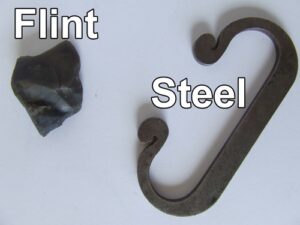
A flint is a type of hard rock.
The steel striker in a flint and steel, is made of high carbon and has been heat treated.
How does a flint and steel create a spark?
A flint is used to slice tiny particles of metal off the steel striker.
The miniature steel pieces ignite when exposed to the air and create a dull spark. The spark is caught in some charred material and then the ember is transferred into a tinder bundle. This is then aerated into flame.
Other rocks like chert, quartz and jasper also work with the steel striker to get sparks. (Generally the term flint might be used by some to refer to any hard rock that is used with the steel.)
Before matches were invented, the flint and steel was used by early mankind. (Before the flint and steel, fiction fire was used to start a fire.)
Because of the dull spark, the flint and steel won’t ignite items into a flame. The spark has to land on something that will take an ember. You have to use either naturally charred plant material, or char material like 100% cotton.
Some selected tinder funguses can catch a spark, but it is generally hard to get an ember. Certain types of seed heads can take a spark, but again it is very limited without charring material first.
How do you char cloth?
The plant material or cloth is put in a tin. The tin has a small hole in it and is placed on the fire. The gasses come out of the hole during the heating process. When the char cloth or material is done, the gasses stop escaping out of the tin.
You can char material naturally in the fire, but it is easier and more controlled to put the material into a tin, on the campfire.
A Trangia spirit stove, backpacking stove and portable gas camping stove can also be used to char the material in the tin.
Lamp wick, jute twine, punkwood, types of bark, different leaves and plant stems can also be used to char. Certain materials char better than others, like some materials will disintegrate and won’t be use-able.
How does a flint and steel work to create a campfire?
For the flint and steel to work to create a fire, a spark has to land on some charred material like char cloth, tinder fungus or charred material.
The spark takes, creating an ember. The ember is transferred to a dry tinder bundle. (Also called a birds nest.) This bundle is then aerated, or blown into flame.
How do you use a flint and steel?
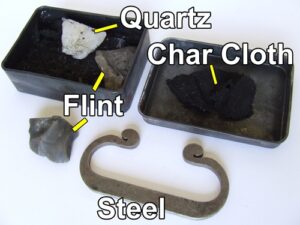
They are two main ways to use a flint and steel. The first way is to place some char cloth on top of the flint.
The flint is held stationary with a sharp edge angled up. With the other hand, the steel striker is struck quickly and firmly with a flick of the wrist angled down onto the edge of the flint. The majority of sparks should go up and catch on the charred material. The ember on the material is then placed into a tinder bundle and blown into flame
A second way to use the flint and steel, is to hold the steel stationary over the char tin. The flint is moved and struck down onto the stationary steel. Sparks will land down into the tin, on the charred material. The tinder is put into the tin and blown into flame. Or the ember is transferred from the tin to the tinder bundle and oxygenated into flame.
The flint and steel does require a lot of patience and perseverance to learn how to do it. However, it isn’t as hard as trying to get a friction fire going, but does require some technique.
Practice getting consistent sparks first, before you try and catch a spark on some charred material.
The flint needs to have a sharp edge for the steel to spark.
Some bushcrafters and survivalists make their own steel with old used files and tools.
Although not practical for most weekend campers, the flint and steel is a lot of fun.
The flint and steel if used with natural charred material can be a sustainable way to light a campfire.
What is a magnesium bar fire starter?
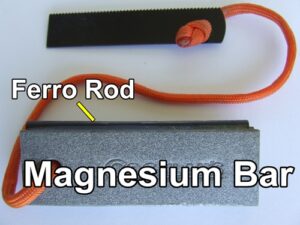
A magnesium bar fire starter can also be called a magnesium block, mag bar or mag block for short. It is normally paired with a small ferro rod glued to it.
The magnesium bar works for fire lighting, by the magnesium pieces being shaved or scraped off. When the pile of magnesium is made, the ferro rod is then scraped quickly and firmly to get sparks, which ignites the magnesium particles. Tinder and kindling is then placed on the flames to get a fire going.
The magnesium bar shavings can burn very hot and help ignite different types of tinder.
Unfortunately there are a lot of cheap manufactured magnesium blocks. These are very hard to get any scrapings of metal from them. Then if you do, they do not ignite very easy or not at all. (Make sure you get a brand name mag bar.)
Most ferro rods that come with the mag block are very small, so you don’t get a lot of sparks from them. The glued on ferrocerium rod also normally falls off.
Another negative of the magnesium fire starter is the metal shavings can easy blow away in the wind. Some people use some tape to catch the shaving. The tape can also be used as a firestarter once ignited.
The shavings are best collected in a depression, so they don’t blow away with the wind.
An ideal mag bar fire starter, would have a high quality magnesium block, that can be shaved easily and burns intensely. It should also have a bigger ferro rod on it, so you can get more sparks.
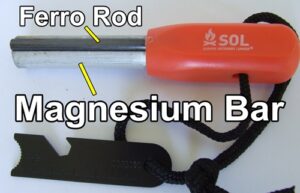
I am playing around with the SOL Mag Fire Starter magnesium at the moment and the magnesium component is very good. You can get good scrapings off it easy and they ignite very nicely. However the ferro rod is probably still a bit small, but it is way better than most magnesium bar fire-lighters.
Fire lighting tips and tinders.
Most ferro rods and mag bar firelighters come with a very short cord or lanyard that makes it hard to strike a spark. Replace this cord with a longer piece of some fire para cord or Jute twine, which can also be used as an emergency fire lighting tinder.
For a good man made tinder, use cotton balls, coated with petroleum jelly. (Vaseline.) This burns for a long time and can help get a fire started in damp conditions.
Collect kindling, fuel and tinder before you try and light a campfire. In damp conditions collect more than you think you will need.
Gather tinder and kindling above off the ground so it isn’t wet. On the dry side of trees, underneath branches can be decent places to get dry materials. Standing dead small trees can be a good source, as they are off the ground and the rain normally runs off it. As oppose to a dead lying tree that the rain collects on it and soaks in.
Fat wood is a great fire starter. It has a high resinous content that the oils help it burn. You can also ignite shavings, sawdust and scrapings of fatwood with a ferro rod. (A flint and steel won’t work directly with fatwood.)
When learning how to make a campfire, a candle is great to take in your camping gear. You can ignite it, then use it to help dry and ignite damp tinder and kindling. Tea candles are small to store and carry and can double up for a light source when backpacking or camping.
If you use a ferro rod, place some prepared cotton balls in a waterproof snap lock bag with a spare Bic lighter. A couple of sticks of fatwood are also a good idea.
Check up and follow the park and camping ground rules and regulations, about where and when you can have an open campfire. Triple check that the campfire is out before you leave. Collect and take home any rubbish you bring.
Carry back up fire lighting gear.
Regardless of how you want to light your camp fire, have a backup fire lighter as well. In case you lose an item or it gets damaged.
Now if you are RV camping in campgrounds and you lose your matches, no big deal. One of the friendly campers will have a spare lighter, etc. However, if you are backpacking off the beaten trail, or fishing deep in the backwoods and you only have one source of fire lighting you can get into trouble. If you lose it or break it, it could literally be dangerous in cold and wet environments.
While you can make friction fire tools like the fire bow drill, it is very hard to collect the right type of woods and materials and get it to work. Even for the experienced bushcrafters and survivalist it is hard, especially in damp and cold environments. So carry extra fire lighting tools when outdoors.
As an example for the camper, you might have a Bic lighter, ferro rod and matches. For the backpacker might have a lighter in their pocket and matches and a ferro rod in their backpack. The bushcrafter might have a flint and steel kit, ferro rod and a Bic lighter as well.
Conclusion. What is a flint and steel & ferro rod?
A flint is a type of rock. A flint and steel is vastly different to a ferrocerium rod.
A magnesium block with a ferro rod on it, is not a flint and steel.
Play around with some fire lighting methods and techniques before you go camping.
Practice with different tinder’s and learn what works and what doesn’t. For the flint and steel you need some patience and it takes more steps to get a campfire going.
Even though a ferro rod and magnesium bar fire starter can get hot sparks or even some flames, it doesn’t mean that it will work with any source of tinder. In wet and damp conditions, trying to get a camp fire going can be hard with these tools, so practice first.
If you are in the wilderness, have dry tinder or some cotton balls and fatwood in a dry bag and carry a backup fire lighting source, like a Bic lighter. Rather than being reliant on one type of tool.
Have fun camping, fishing and exploring the outdoors and be safe.
